TARGETS
Lillian Balsvik
James Stephen Henry
Julia Kagge
Rikke Pihlstrøm
ENGELSK Vg1

Lillian Balsvik
James Stephen Henry
Julia Kagge
Rikke Pihlstrøm
ENGELSK Vg1
Lillian Balsvik
James Stephen Henry
Julia Kagge
Rikke Pihlstrøm
ENGELSK Vg1

Læreboka Targets er en del av læreverket Targets Targets følger læreplanen i engelsk, Vg1 studieforberedende utdanningsprogram (LK20).
© H. Aschehoug & Co. (W. Nygaard) 2020 5. utgave / 2. opplag 2022
Materialet er vernet etter åndsverkloven. Uten uttrykkelig samtykke er eksemplarfremstilling, som utskrift og annen kopiering, bare tillatt når det er hjemlet i lov (kopiering til privat bruk, sitat o.l.) eller i avtale med Kopinor (www.kopinor.no).
Utnyttelse i strid med lov eller avtale kan medføre erstatnings- og straffansvar.
Redaktør: Ingun Kjelsvik Holøyen
Grafisk formgiving: Mona Dahl
Omslag: Mona Dahl
Bilderedaktør: Kathrine Klinkenberg
Tekniske tegninger: Irene Løhre
Illustrasjoner: Johan Reisang s. 14, 328, Christine Clemmensen s. 26, 266–267, 279, øvrige Mona Dahl
Grunnskrift: ITC Franklin Gothic Book
Papir: 100 g G-print 1,0
Trykk: 07 Media AS Innbinding: Bokbinderiet Johnsen AS
ISBN 978-82-03-40835-9 Aunivers.no
You have just started upper secondary school, and this is the last year you will study English as a compulsory subject. English is a key subject for cultural understanding and communication. Also, it will prepare you for further education and work, where English language competency is increasingly important.
Targets has seven chapters. Five of them take you on a journey through the English-speaking world through different text types of varying length. The tasks that follow will help you understand the text and explore the topic in more detail. Chapter 2 is called “Target Your Skills”. In this chapter you will find material to help you with strategies for listening, speaking, reading and writing. You should work with and use these strategies throughout the year. The final pages of each chapter contain “Language Work”, a set of language tasks. These tasks start with basic work on word formation and dictionary use, and, gradually, focus on other, more advanced, areas of English usage. Most of these tasks have a reference to a specific page in chapter 7, which is where you will find information on the rules of the English language.
Accompanying this textbook is the Targets website, which you can access at Aunivers.no. On the website you will find
• activities and tasks to help you prepare for the exam
• activities and tasks connected to current events in the English-speaking world
• activities to help you evaluate your own progress in learning English
• activities to further improve your oral, written and digital skills
• templates and model texts
• additional factual and fictional texts with tasks
• shorter versions of the longer factual texts from the textbook
We wish you the best of luck with the course, and hope you will enjoy learning English this year.
Chapter 1 Let’s Communicate TitleAuthorGenrePage
A Day’s WaitErnest
How Different Are American and British English factual text49
Chapter 2 Target Your Skills
TitlePage
Getting to Know This Chapter55
Unit 1: Listening56
Listening56
Unit 2: Speaking57
Having a Conversation57
Discussion and Debates59
Giving a Presentation60
Unit 3: Reading62
Approaching a Factual Text63
Reading Fiction across Cultures64
Learning Vocabulary65
Identifying Literary Devices69
Analysing Short Stories70
Analysing Film71
Analysing Poetry and Songs73
Analysing Visual Art74
TitlePage
Unit 4: Using Sources75
Finding and Evaluating Sources75
Commenting on Trends and Statistics77
Citing and Referencing79 Unit 5: Writing80
Five-Paragraph Essay80
Brainstorming81
Audience, Purpose and Text Type82
Research Question82 Introduction83
Paragraphs84
Conclusion86
Text Types87
Developing Critical Thinking90
Formal and Informal Style92
Revising Your Text93
TitleAuthorGenrePage
Communicating with Picturesfactual text98
Who’s That Girl?factual text / photo100
Online Rights and Responsibilitiesfactual text101
Investigative Journalismfactual text102
Spotlight – The Moviefilm corner104
The MurdererRay Bradburyshort story107
Media Literacyfactual text116
Who Do You Listen To?factual text119 We Are All Biasedfactual text122
Language Workgrammar exercises128
TitleAuthorGenrePage
The RiverBruce Springsteensong lyrics131
The American Dreamfactual text134
The USA – A Patchwork Nationfactual text137 12 Years a Slavefilm review144
Thank You, M’amLangston Hughesshort story147
SnowJulia Alvareznovel extract152
American Governmentfactual text156
Gun Rights vs. Gun Controlfactual text / speech extract 162
Fixed IncomeSherman Alexieshort story165
The Changing Face of Americafactual text168
How Different Are Canada and the USA?table / factual text174
The Moose and the SparrowHugh Garnershort story177
Time Capsule Found on the Dead PlanetMargaret Atwoodshort story185
Language Workgrammar exercises191
TitleAuthorGenrePage
The BritishBenjamin Zephaniahpoem193
Young Voices factual text196
Understanding Britainfactual text199
A Divided Countryfactual text206
My FutureSarah Crossan, Brian Conaghan poem209
The Selfish Giantfilm corner211
British Governmentfactual text212
Blinded by the Light: Film ReviewPeter Bradshawfilm review215
My Son the FanaticHanif Kureishishort story217
Northern Ireland Q & Aquestions and answers229
The SniperLiam O’Flahertyshort story235
Father and SonBernard MacLavertyshort story240
Ireland – True or False?quiz247
Language Workgrammar exercises250
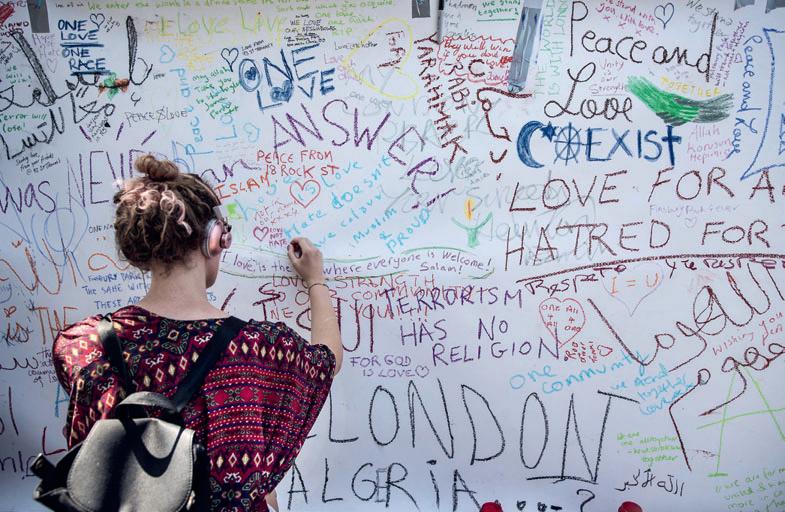
TitleAuthorGenrePage
Unit 1: English as a Global Language253
Our Strange LingoLord Cromerpoem253
The Power of Englishfactual text256
American Superpowerbullet points262
English as a Global Languageinfographic263
Unit 2: Australia and New Zealand265
Australiainfographic266
BlancamorphosisJannali Jonesshort story270
New Zealandinfographic279
ButterfliesPatricia Graceshort story281
Films about Australia and New Zealandfilm corner284
Unit 3: Africa
287
English in Africafactual text / map287
South African Englishquiz / factual text289
A Letter by Way of ExplanationMuhsin Hendricksletter292
My Mother, the Crazy AfricanChimamanda Ngozi Adichie short story296
The Boy Who Harnessed the Windtalk / film corner305
Films about Africafilm corner306
Unit 4: India and Pakistan 308
India and Pakistan: Fast Factsfacts / statistics308
Good Advice Is Rarer Than RubiesSalman Rushdieshort story310
AnilRidjal Noorshort story316
Films about Indiafilm corner325
Language Workgrammar exercises326
Chapter 7 Grammar
See page 329 for contents in detail.
For exam preparations, please visit Aunivers.no.

MAIN FOCUS
• improving your communication skills
• exploring different forms of communication
• reading various types of texts about communication
• reflecting upon cultural expressions: literature, visual art, music, games
• improving your writing: note-taking, paragraphs, persuasive texts
• improving your strategies for learning and expanding your vocabulary
• expressing yourself accurately and according to purpose and situation
• language focus: words and phrases
BEFORE YOU READ
Show a partner one of your favourite pictures. Where and when was the picture taken, and why do you like it so much? In your opinion, what is a good picture?
pioneering banebrytende/ banebrytande display stille ut visible synlig/synleg surface overflate mural painting veggmaleri/veggmåleri cause a stir lage oppstyr, vekke oppsikt / lage oppstyr, vekkje oppsikt
BANKSY (1974–) , whose work is celebrated worldwide, has gone to a lot of trouble to stay anonymous. It is assumed that Banksy was born and raised in Bristol, England. He has for twenty years displayed his pioneering art on publicly visible surfaces and is well-known for his mural paintings. You never know where a picture by Banksy might appear because he never asks for permission in advance. Banksy’s pictures tend to cause a stir, and he is labelled as a political activist, an artist and a vandal.
Mobile Lovers originally appeared in Bristol in 2014. What is the couple looking at?
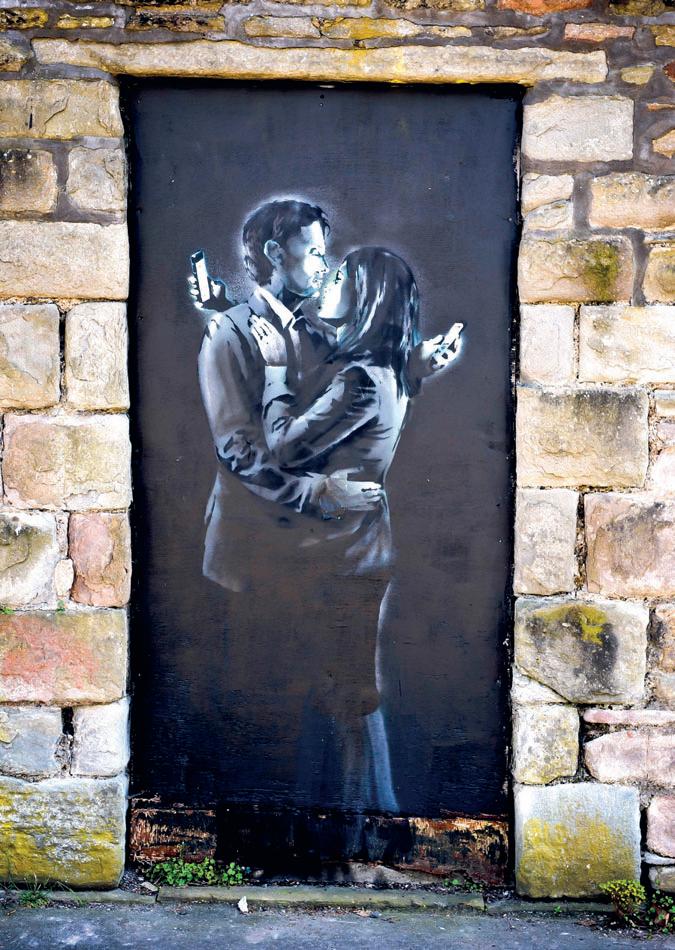
This untitled piece of graffiti appeared on Israel’s separation wall between Jerusalem and Ramallah on 16 January 2006. Why is the setting of the painting important?

“Art should comfort the disturbed and disturb the comfortable.” –Banksy
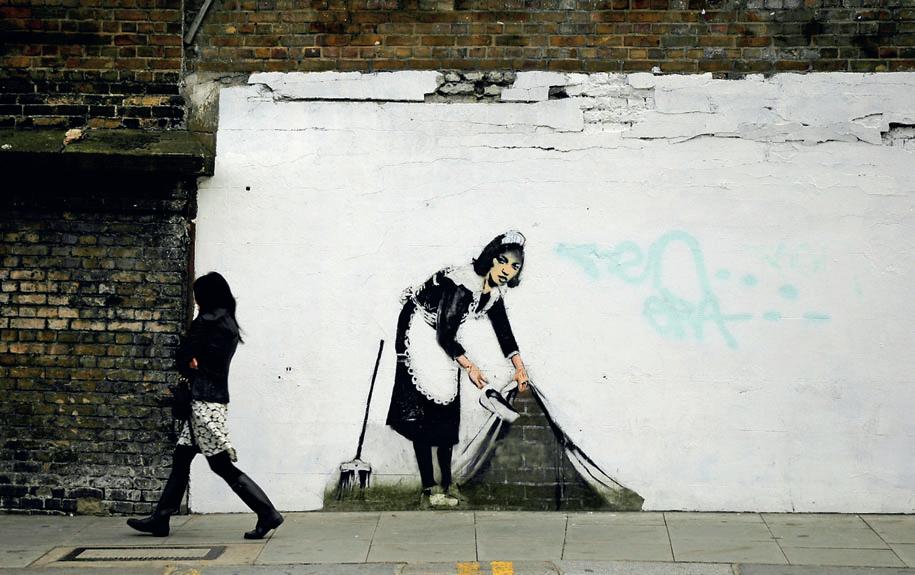
Discussing visual images
1 a What do these Banksy pieces depict? Why do you think Banksy painted these pictures? What can these visual images tell us about today’s society?
b What do you like or dislike about the pictures?
c Who are the target groups for these pictures?
d To what extent is the location of the paintings important?
e Do you ever go to art exhibitions? Why or why not?
f Why do you think Banksy has chosen mural paintings as his way of communicating?
g Why do you think Banksy has become so popular?
h Do you consider Banksy to be an artist, a vandal, an activist, or a combination of these?
i Why do you think Banksy has gone to so much trouble to stay anonymous?
Making a presentation
2 Make a presentation of three to six of Banksy’s paintings and present it to a partner. The presentation should contain bullet points on target groups/ audience, the message and what you like or dislike about the pictures. Also, comment on whether his art should be described
as vandalism, graffiti or street art. If possible, include information about the setting of the paintings. You can find numerous pictures of his art online. Check out Banksy’s own website, banksy. co.uk, and his Instagram account.
Role-playing: The art of persuasion
3 Imagine this scene: Matthew Williams earns his living by renting out garages downtown. One day he and his daughter Ella discover a mural painting by Banksy on one of his garages. Matthew is furious about this and wants to remove the spray paint immediately. Ella, however, argues that Banksy is not an irresponsible vandal but an iconic and pioneering artist whose work should be appreciated by everyone.
In pairs, act out the scene. Before you start, write down three to four arguments to support your character’s claim. Afterwards, discuss the persuasive techniques that each of you used. (See page 27.) Were they successful?
Getting an overview of this book
4 Look quickly through this textbook and identify six to 10 favourite pictures. Compare your pictures with a partner. Based on the pictures, what do you think you will learn this year?
Play this game to get to know each other better. Work in groups of four. Each group need a dice and each student needs a piece – maybe a paper clip or an eraser. Throw the dice.
The weirdest thing I’ve ever seen is …
If I were an animal, I’d be … My dream summer
Move back three spaces
I’m happy when …
If I could travel through time, I’d …
I dislike …
A place I’d like to visit is …
The person I text the most is …
On my birthday I …
I’m currently listening to …
When I sleep, my cell phone is …
City, beach or mountain?
Move forward three spaces
Three things you can do to live greener are …
Things I value the most are …
A book I have read is …
Snapchat, Facebook or Instagram? I wish …
The languages I speak or understand
Move forward three spaces
From my bedroom window I see …
If I had superpowers, I’d …
If I could be invisible for a day, I’d …
Move back three spaces
My favourite film/ series is … A famous person I’d like to meet is … I need …
I’m passionate about … I relax when …My favourite food is … By 2035 I hope I …
Which languages influence your life, and in what way? Make a list.
• I speak German with my parents. They are both German, and they moved to Norway just before my older brother was born.
• I live in Norway, so when I’m at school and with my friends, I mostly speak Norwegian.
• I speak English when I’m gaming, and I watch English TV series. I’m a Tottenham supporter, and after Tottenham’s matches, I discuss what happened on online fan forums. I also browse Twitter for other fans’ responses. I read books in English, and most of the music I listen to has English lyrics.
• I learn French as a foreign language at school.
• I grew up with Swedish children’s TV.
• I often travel to Copenhagen, because I have a friend who lives there.
• This summer I was on holiday in Barcelona with my family, and I managed to order ice cream in Spanish.
• My best friend speaks Arabic with his parents.
• When I speak to my dog, Bibi, I use a mixture of Norwegian, German, English, and French. He responds to all languages.
Understanding the text
1 Elaborate on the list from your pre-reading task, using the example above as inspiration. Make a short presentation for a partner.
2 How can the other languages you know help you when you learn English? Make notes to prepare for task 5 below.
SPEAKING
Making a presentation
3 Use your list from task 1 above to make a short presentation for a partner.
4 Create a poll: Which languages do students in your class speak? Differentiate between being able to communicate fluently, well, and on a basic level.
5 In pairs, interview each other. In what way do you think the other languages you know have affected your English learning?
Julie grew up in France, speaking French. She finds the English words she is surrounded by easy to understand. Do you agree? Why do you think they are easy for Julie, while someone who grew up in Norway, speaking Norwegian, would find them advanced? Find the origin of the words. Are any of Julie’s words easy for Norwegians as well?

Per grew up in Norway, speaking Norwegian. The English words he is surrounded by are easy for him. Find their origin. Would any of these words be easy for Julie as well?

Ali grew up in Beirut, speaking Arabic. The English words he is surrounded by are easy for him. Find their origin. Would you have known any of these words if you did not speak any English? Why, do you think? Do you think the same words would be easy for Julie and Per?

BEFORE YOU READ
Analyse Vingo, the main character in this short story, by using the star diagram below. While you read the story, fill in information about Vingo. Describe how he looks and what he says and does.
looks does wants problems says
PETE HAMILL (1935–) was born in Brooklyn, New York, to immigrant parents from Belfast, Northern Ireland. As a journalist, he travelled the world and won many professional awards. “Going Home” was originally written for the New York Post in 1971.
They were going from New York to Florida. There were six of them, three boys and three girls, and they got on the bus in the city centre, carrying sandwiches and wine in paper bags, talking excitedly. They were dreaming of golden beaches and blue sea as the grey, cold spring of New York vanished behind them. Vingo was on the bus from the beginning.
As the bus passed through New Jersey, they began to notice that Vingo never moved. He sat in front of the young people, his dusty face masking his age, dressed in a suit that did not fit him. His fingers were stained from cigarettes and he was chewing his lips all the time. He sat in complete silence.
Deep into the night the bus pulled into a roadside café and everybody got off the bus except Vingo. The young people began discussing him, trying to imagine his life. Perhaps he was a sailor; maybe he had run away from his wife. He could be an old soldier going home or a lonely, old bachelor. When they went back to the bus, one of the girls sat beside him and introduced herself.
“We’re going to Florida,” the girl remarked, interrupting the man’s thoughts. “Are you going that far?”
excitedly oppstemt/oppstemd vanish forsvinne dusty støvet/støvete stained flekket/flekkete chew tygge/tyggje pull into svinge inn imagine forestille seg / tenkje seg bachelor ungkar remark si, bemerke / seie, ytre interrupt avbryte reluctantly motvillig admit innrømme navy marinen retreat trekke seg tilbake / trekkje seg tilbake
“I don’t know,” Vingo answered reluctantly.
“I’ve never been there,” she said. “I hear it’s beautiful.”
“It is,” he admitted quietly, as if remembering something he had tried to forget.
“Do you live there?”
“I was there in the navy.”
“Do you want some wine?” she asked. He smiled and took a drink from the bottle. Then he thanked her and retreated again into his silence.
In the morning the bus passengers awoke outside another café and this time Vingo went in. The girl insisted that he should join her group. He seemed very shy, and ordered black coffee and smoked nervously,

as the young people enjoyed themselves, chattering about sleeping on beaches. When they went back to the bus, the girl sat with Vingo again. She was determined to find out more about him. After a while, slowly and painfully, he began telling his story. He had been in jail in New York for the past four years, and now he was going home.
“Are you married?”
“I don’t know.”
“You don’t know?” she asked, surprised by the unexpected answer.
“Well, when I was in jail I wrote to my wife. I told her that I could understand if she didn’t want to stay married to me. I said I was going to be away a long time, and that if she couldn’t stand it, if the children kept asking questions, if it hurt her too much, well, she could just forget me. She could get a new man – and forget about me. I told her she didn’t have to write to me or anything, and she didn’t. Not for three and a half years.”
“And you’re going home now, not knowing what the situation is?”
“Yes,” he said shyly. “Well, last week when I was sure I was going to
release løslate / setje fri handkerchief lommetørkle appearance tilsynekomst tighten stramme tremble skjelve fade bli svakere / bli svakare fist neve
dozens dusinvis banner fane billowing bølgende/bølgjande
be released from prison, I wrote to her again. I told her that if she had a new man I would understand. But if she didn’t and if she wanted to take me back, she should let me know. We used to live in Brunswick, and there’s a great big tree just as you come into the town. I told her if she would take me back, she should put a yellow handkerchief on the tree, and I would get off and come home. If she didn’t want me, there would be no handkerchief and I would keep on going through the town.”
“Well!” remarked the girl. “What a story!”
The girl told the others and soon they were all involved, looking at the pictures Vingo showed them of his wife and children. When the bus was twenty miles from Brunswick, the young people took window seats on the right side, waiting for the appearance of the great tree. Vingo stopped looking, tightening his face as if expecting another disappointment. Then it was ten miles, then five. Vingo was trembling. The noise of people faded and the bus became very quiet.
What do you think will happen next?
Then suddenly all of the young people were up out of their seats, screaming and shouting and crying, doing little dances and shaking their fists in triumph. But Vingo ignored their behavior. He just sat there, looking at the tree. It was covered with yellow handkerchiefs, dozens of them. The tree stood like a banner of welcome, blowing and billowing in the wind. As the young people shouted, the man rose slowly in his seat, collecting his belongings. He made his way to the front of the bus. He was really going home.
HOW TO MAKE A REFERENCE TO THIS TEXT
Hamill, Pete. 2020. “Going Home”. In Balsvik et al. Targets. 16–18. Oslo: Aschehoug.
Starting a conversation
How’s it going?
It’s very nice to meet you.
Hi, my name’s Jenny. I’d offer to shake your hand, but I broke my arm while rock climbing last week.
Good morning. It’s a pleasure to meet you.
I don’t think we’ve met – I’m Shayna.
Hi, my name’s Sarah.
What’s up?
How do you do?
I’m John Gilmore. Nice to meet you.
How are you?
I’m Joe. It’s nice to meet you.
Alright, mate?
Understanding the short story
1 Answer the following questions.
a Discuss the protagonist with a partner by comparing star diagrams.
b Where and when is the short story set? When was the short story published? To what extent is the setting important in this short story?
c Why do you think Vingo is chewing his lips all the time?
d What has he done in New York?
e What differences do we notice between the young people on the bus and Vingo?
f Why does Vingo not know whether he is married or not?
g Why did Vingo write to his wife when he realized that he would be released?
h How does he realize that his wife wants him to come home?
Analysing the short story
2 Answer the following questions. Discuss with a partner.
a The girl who talks to Vingo on the bus is one of the minor characters in this short story. Vingo’s wife is an “unseen character”, which means that she is never directly “observed” by the reader. Compare and contrast these two characters.
b Do you feel that you get to know the girl better than the wife?
c To what extent is nonverbal communication a significant aspect of the short story?
d Do you agree that in this story, actions speak louder than words?
e Despite his situation, Vingo seems composed and in control of his feelings. However, what would you do if a stranger sitting next to you on the bus suddenly lost control of his feelings and burst into tears?
Starting a conversation
3 Starting a conversation with someone you do not know can be difficult. To the left you will find various opening sentences. Some are rather formal, some are rather informal and some openings could be considered both. Copy the grid below and use it to organize the opening phrases.
Writing a diary entry
4 Imagine that you are Vingo. A few days after your return home, you take up the old habit of writing a diary. Write a diary entry where you describe what you have been doing the last few days. What surprises you? What scares you? What makes you cry? What are the unexpected joys of being a free man? How do you relate to your wife and children?
Writing about literature
5 Write an analysis of the short story. Use the grid on page 70 as a starting point.
6 Yellow ribbons are a national folk symbol in the USA. Find out why.
7 There is a popular song called “Tie a Yellow Ribbon Round the Ole Oak Tree”. Find the song online. How does it compare to “Going Home”?
8 Symbols and emojis: Look at the symbols and emojis below. Do you know what they stand for? Why do you think symbols and emojis are becoming more and more popular in modern communication?



The indefinite article



9a When do we use “a” and when do we use “an”? Learn about the indefinite article on page 340.
b Check whether you need to work on the use of the indefinite article: ... answer, ... bus, ... jail, ... introduction, ... while, ... hour, ... handkerchief, ... oak tree, ... year, ... ribbon
Which social media platforms do you use? In what ways do you use, for example, Facebook, Instagram, YouTube, Twitch, Snapchat or any others?
The word communicate comes from Latin and means “to share”. When you share information with someone, by either speaking, writing or posting a photo on Instagram, you communicate. One of our basic needs is to share and exchange information. Sharing information with a friend you bump into on the street is not too difficult: “How are you?” “I’m all right, thanks. How are you?” Physical distance can make communication difficult, and the longer the distance, the more challenging it can be. In the history of humankind, our methods of communication have seen some remarkable developments. Today, modern technology plays a key role in our lives. In what ways has the digital revolution affected the way we communicate?
Your parents grew up with traditional media like TV, radio, magazines and print newspapers. The texts were written and edited by journalists and editors, then printed and distributed to a large number of people. As a reader, listener or viewer of traditional media, you had limited ability to express your views on a specific matter. You could, of course,
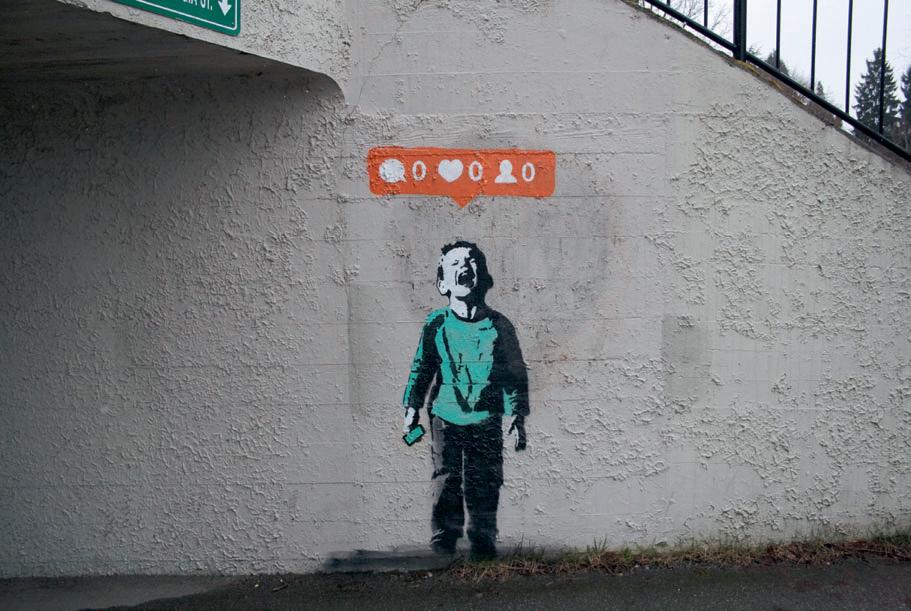
discuss a news story with your friends and family and even write a letter to the editor, which might be published in the newspaper a week later. Yet, traditional media can be described as a one-way street where journalists and editors create and edit most of its content.
Today we have both printed and online newspapers. You can read an article in an online newspaper, then comment on the online article, and your comments will be published immediately. Nevertheless, online newspapers are also considered to be a one-way street because the journalists and editors still create and edit the majority of the online content. Social media, on the other hand, can be described as a twoway street. Advances in technology enable social media users to create and share content or participate in social networking.
With the creation of Facebook in Mark Zuckerberg’s Harvard dorm, a new era in social media was initiated. In 2004, Facebook started out as a website for Harvard students only, but by 2019 it had 2.4 billion monthly active users. On Facebook, people share their personal information and thoughts online, even with “friends” they hardly know. Whereas Facebook is a social network for personal use, LinkedIn is a business-oriented network. LinkedIn was launched in 2003, and 17 years later it is estimated that the network has more than 260 million monthly active users. Instagram is an online photo-sharing and videosharing social network. Launched in 2010, this service is now believed to have over 1 billion monthly active users.
According to the Pew Research Center’s survey on social media use among adults in the USA in 2018, Facebook and YouTube are the most popular social media platforms. As illustrated in the table below, social media sites like Instagram, Pinterest and Snapchat are also popular. The survey also shows that younger Americans, aged 18 to 24, stand out for embracing a variety of platforms. In this group, 78 per cent use Snapchat, 71 per cent use Instagram and 45 per cent are Twitter users. All these platforms develop their own unique words, expressions and ways of interacting.

Digital media also impacts the way we speak. In 2013, Oxford Dictionaries announced the word selfie as their international Word of the Year. The noun selfie can be traced back to an Australian online forum in 2002. Over the years, it has gained momentum throughout the English-speaking world. It is no longer only a social media buzzword but also a mainstream shorthand for a self-portrait photograph. Among other words that made headway in 2013 were binge-watch, defined as watching “multiple episodes of a television programme in rapid succession,” and bitcoin, a digital currency in which transactions can be performed. In addition, the tech company name Google has now been turned into the verb to google and the company name Twitter has given us both the noun and the verb tweet. Modern technology has also impacted the Norwegian language, and today we “googler”, “twitrer” and “vippser”. Some might claim that the increasing number of English words in the Norwegian everyday language enriches the language, while others would argue the opposite. They feel that if English words take over more and more of our conversation in Norwegian, we might lose our own language and along with that part of our own identity.
basic need grunnleggende behov / grunnleggjande behov exchange utveksle remarkable utrolig/utruleg affect påvirke/påverke ability evne edit redigere dorm (dormitory) internat initiate innlede/innleie era æra, epoke launch lansere have an impact on ha virkning på / ha verknad på gain momentum her: skyte fart, bli vanlig / skyte fart, bli vanleg buzzword moteord mainstream shorthand vanlig forkortelse / vanleg forkorting rapid succession rask rekkefølge / rask rekkjefølgje currency valuta transaction overføring claim hevde enrich berike / gjere rikare benefit fordel pitfall felle, fallgruve
Modern technology certainly brings considerable advantages. For example, it can improve your English. Playing video games online with international friends and watching Twitch, the world’s leading live-streaming platform for gamers, can have a positive impact on your communication skills. In addition, there is big money in social media for the top players. The Kardashians, for example, with a combined Instagram audience of 538 million followers, have come up with a unique combination of celebrity, wealth, entrepreneurship, family and media to create their success. Today the momager Kris and her daughters, Kourtney, Kim, Khloé, Kendall and Kylie, make up one of America’s most famous families. Additionally, the magazine Forbes ranks the youngest Kardashian, Kylie, aged 21, as the world’s youngest billionaire. Perhaps the most important advantage of modern technology is the fact that anyone who is online can access so much information. This means that we can educate ourselves, participate in discussions worldwide and easily stay in touch with family and friends.
However, some people might argue that social media is sabotaging real communication. As pointed out by the New York-based communication executive Susan Tardanico, our interactions at breakneck speed through social media may actually damage communication. In social media, we can hide our true feelings behind the Facebook post or the tweet and create an illusion of our own choosing. According to Tardanico, only 7 per cent of communication is based on the written or verbal word, whereas 93 per cent is based on nonverbal body language. Therefore, a face-to-face response to the question “How are you?” is likely to provide you with more accurate and correct information about a person’s true feelings than an online emoticon.
Modern communication definitely has its disadvantages. While most of us enjoy our online life by liking updates, uploading pictures and
searching for our next vacation spots, the platforms we use track our movements, and this information becomes a commodity that can be bought and sold. So, if a woman uploads a picture of herself with a newborn on Facebook, it is likely that ads for nappies very soon will pop up on her Facebook page. Or if you search online for hotels in Berlin, ads for hotels in Berlin might pop up next time you read Dagbladet online. This kind of advertising is usually far more efficient than paying for a whole page in a printed nationwide newspaper. This makes the owners of popular online platforms rich, but many people dislike the idea of constantly being monitored online. In addition, many claim that modern communication has a negative impact on young people’s self-esteem. It is impossible to live up to the photoshopped pictures of celebrities online, and maybe the need for likes and views on updates limits our offline lives. Above all, hate speech online has taken bullying to a new level, and this makes it more difficult to feel safe and comfortable online.
To sum up, modern technology has truly changed the way we communicate. It is difficult to imagine a life without the World Wide Web. Now we can interact 24/7 with more people than ever before. While enjoying all the benefits of digital communication, we also need to be aware of its pitfalls. How do we balance our offline and online lives? What will happen next?
(Sources: OxfordDictionaries.com, Pew Research Center, Susan Tardanico)
HOW TO MAKE A REFERENCE TO THIS TEXT “Communication Today”. In Balsvik et. al Targets. 2020. Oslo: Aschehoug.
WORD BANK
at breakneck speed
binge-watch digital media
digital revolution
face-to-face response
hate speech
impact
interact 24/7
modern communication
modern technology
monthly active users
online gaming online life online newspapers sabotage social media
social media use traditional media update

READING
Understanding the text
1 Answer the following questions
a What does the word communicate mean?
b Traditional media can be described as a one-way street. Why?
c Social media can be described as a two-way street. Why?
d Social media takes on many different forms. Name a few examples.
e Look at the graph from the Pew Research Center on p. 21 and describe social media use among adults in the USA in 2018.
f In what ways does digital media impact the way we speak?
g What are the advantages of modern communication?
h Identify some of the disadvantages of modern communication.
Taking notes: Factual texts
2 Analyse the structure of the text. The main idea of each paragraph is presented in the topic sentence. Fill in the main point and supporting ideas of each paragraph. Afterwards, underline the most important words in your notes, about 20–25 words. Note: The introduction in a factual text differs from the other paragraphs because there is usually not a topic sentence at the beginning of the paragraph but rather a question at the end of the paragraph. There is therefore no need to fill in supporting ideas in the introduction or in the conclusion.
and 45 per cent are Twitter users. Why do you think that young Americans seem to stand out for embracing Snapchat, Instagram and Twitter? What is your own relationship to Snapchat, Instagram and Twitter?
b Try to estimate how much time you spend on social media. Instagram has made it possible to check how much time you have spent on their platform. Should all platforms be obliged to update you on how much time you have spent on their platform?
c Who are your favourite Instagrammers or vloggers? Where do they live? Why are they popular? How much money do they earn? Do you think that they will continue to be popular for the next five years?
d The communication executive Susan Tardanico states that social media is sabotaging real communication. Discuss this statement by presenting both arguments that support this claim and counterarguments.
e The online platforms we use usually track our movements. They keep record of the stories we read and of our “likes”. Often, they sell this information to other companies. Should this be made illegal? Discuss arguments to support the claim and counterarguments.
f Medietilsynet in Norway states that one in four Norwegians aged 9–16 have experienced cyberbullying at least once. According to the Golden Rule, we should treat others the way we want to be treated. Could the Golden Rule serve as a useful starting point for a discussion about cyberbullying?
4 WePC claims that there are more than 2.5 billion video gamers worldwide and that the video game market is expected to be worth over 90 billion US dollars by 2020.
In pairs, do some research on gaming and make a presentation:
• What is gaming?
• What are the most played video games?
SPEAKING
Expressing opinions
3 Work in groups and discuss the following topics.
a The survey from the Pew Research Center points out that Americans, aged 18 to 24, stand out for embracing a variety of platforms: 78 per cent of them use Snapchat, 71 per cent use Instagram
• Why is gaming favoured by so many?
• Who are currently the most popular gamers, and why are they so popular?
• What are the positive effects of gaming?
• What are the negative effects of gaming?
• Do you like gaming yourself? Why or why not?
Imagine that you are 17-year-old Noah, who has just read about Meat Free Mondays. You are excited about the idea and decide to talk your family into trying it out. Your hope is that you will eventually stop eating meat altogether. You know it will be difficult to persuade your meat-loving parents, so you need to prepare well and be creative. Brainstorm ideas for effective ways to achieve what you want.
BENJAMIN ZEPHANIAH (1958–) is a British Jamaican Rastafarian writer, poet, lecturer and musician. He is dyslexic and quit school early, but he loves to write and perform. He became a vegan at a young age and explains his choice like this: “As the only black kid in my primary school playground, animals had become my friends. By 15 I was vegan, although I didn’t give up honey until 16.”
This poem is from his book of poetry Talking Turkeys (1995).
BENJAMIN ZEPHANIAH
To talk turkey is an American idiom which means “to talk seriously and honestly about an issue”.
Be nice to yu turkeys dis christmas
Cos turkeys just wanna hav fun
Turkeys are cool, turkeys are wicked
An every turkey has a Mum. Be nice to yu turkeys dis christmas, Don’t eat it, keep it alive, It could be yu mate an not on yu plate Say, Yo! Turkey I’m on your side.
I got lots of friends who are turkeys
An all of dem fear christmas time, Dey wanna enjoy it, dey say humans destroyed it An humans are out of dere mind, Yeah, I got lots of friends who are turkeys Dey all hav a right to a life, Not to be caged up an genetically made up By any farmer an his wife.
persuade overtale lecturer foreleser/førelesar vegan veganer/veganar wicked (slang) her: fantastisk caged up satt i bur / sett i bur genetically made up genmodifisert chop hugg, slag / hogg, slag waste sløse greens grønnsaker/grønsaker partake ta del i delighted glad
Turkeys just wanna play reggae Turkeys just wanna hip-hop
Can yu imagine a nice young turkey saying, ‘I cannot wait for de chop’?
Turkeys like getting presents, dey wanna watch christmas TV, Turkeys hav brains an turkeys feel pain
In many ways like yu an me.
I once knew a turkey called Turkey
He said ‘Benji explain to me please, Who put de turkey in christmas
An what happens to christmas trees?’
I said ‘I am not too sure turkey
But it’s nothing to do wid Christ Mass
Humans get greedy an waste more dan need be An business men mek loadsa cash.’
Be nice to yu turkey dis christmas
Invite dem indoors fe sum greens
Let dem eat cake an let dem partake In a plate of organic grown beans, Be nice to yu turkey dis christmas
An spare dem de cut of de knife, Join Turkeys United an dey’ll be delighted
An yu will mek new friends ‘FOR LIFE’.
HOW TO MAKE A REFERENCE TO THIS TEXT
Zephaniah, Benjamin. 2020. “Talking Turkeys!!!”. In Balsvik et al. Targets. 25–26. Oslo: Aschehoug.
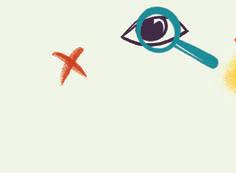






































Reading poetry
1 Answer the following questions. (For more on analyzing poetry, see page 73.)
a In pairs, read the poem aloud. Take turns and read four lines each.
b Which parts of the poem come across as funny? Why do you find them funny?
c The turkey is given human qualities in this poem. This literary device is called personification. Identify some examples of personification in the text. Why do you think Zephaniah has given the turkey human qualities?
d When two or more words in a row start with the same letter or sound, we call it alliteration. Find an example of alliteration in the poem.
e Identify examples of end rhyme and internal rhyme in the poem.
Discussing poetry
2 Discuss with a partner.
a The sentence “Be nice to yu turkeys dis christmas” is repeated four times. Discuss why.
b In what ways is Zephaniah’s language influenced by Jamaican English. What effects does this create?
c Why do you think Zephaniah wrote this poem?
Role-playing: The art of persuasion
3 Hannah has found a lovely Louis Vuitton handbag online. Since her eighteenth birthday is coming up, she decides to talk her father into giving her this handbag as a birthday present. Usually, Hannah
would have settled for something more affordable. However, last night she overheard her dad telling her mum that he has just been promoted, which will involve a significant pay rise. Yet, when Hannah approaches her father, he declares that the handbag is a waste of good money.
In pairs, act out the scene. Before you start, write down three to four arguments to support your character’s claim. Afterwards, discuss the persuasive techniques that each of you used. Were they successful?
Persuading your audience
See also page 88.
In persuasive speech or writing, the key is to make an effective argument. Here are three approaches to the art of persuasion:
Pathos (emotion): Use words and examples that appeal to the emotional side of your audience.
Logos (logic): Use facts, statistics and examples. Ethos (credibility): Make your audience believe you are an expert, or refer to someone who is.
Writing a persuasive speech
4 Write a speech where you try to persuade your fellow students to adopt a greener lifestyle. Your focus statement is “Because of the climate changes, everyone should adopt a greener lifestyle”.
Writing a paragraph
5 Write a paragraph about the poem “Talking Turkeys!!” Start your paragraph with this topic sentence: “According to Benjamin Zephaniah, we should all stop eating turkey.”
ON YOUR FEET!
Battle
“Because of the climate changes, everyone should adopt a greener lifestyle.”
Step 1: Divide into groups of four. Half of the groups prepare six to eight arguments to support the statement above. The other half will prepare six to eight arguments against the statement.
Step 2: Each support group pairs up with an against group.
Step 3: Each group decides on a spokesperson. The spokesperson sits on a chair facing the spokesperson of the opposing group, with the other team members behind them.
Step 4: The two spokespersons start the discussion. The other team members can, whenever they want to, tap the spokesperson on the shoulder and become the team’s new spokesperson.
Let the discussions carry on for as long as possible. Prepare for some noise!
For inspiration, see infographic on page 26.
Targets følger læreplanen i engelsk, Vg1 studieforberedende utdanningsprogram (LK20).
Targets består av lærebok med tekster og oppgaver samt en rikholdig digital ressurs som du finner på Aunivers.no.
Læreboka finnes også i digital utgave med innlest lyd.
ISBN 978-82-03-40835-9
ISBN 978-82-03-40835-9